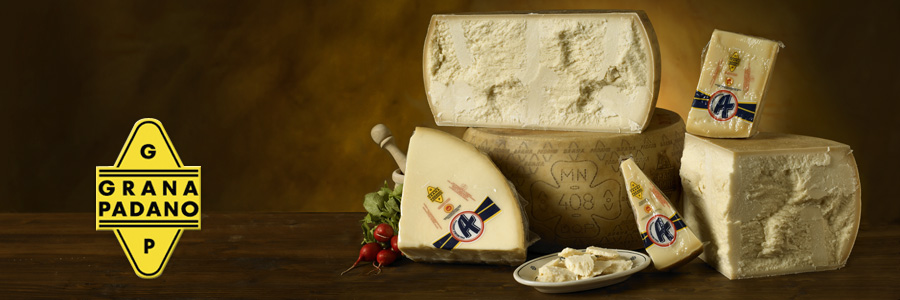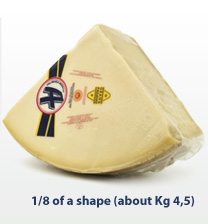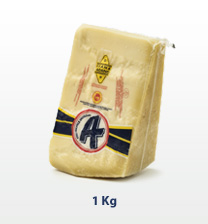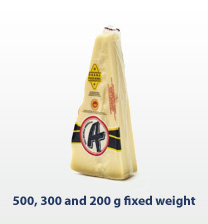- Products
- Grana Padano

The classical Grana Padano is traded in entire shape (about 38 Kg) or cut and vacuum-packed in packing of 500, 300 and 200g fixed weight.



Il Grana Padano is a semi-fat hard cheese and cooked with a slow maturation from 10 to 30 months.
It is a food rich in animal proteins, calcium and mineral salts and can be used both grated on different dishes and as table cheese.
Furthermore, it is a very digestible cheese, suitable for children’ nutrition and pregnant women, older people above all because it strengthen bones and for sportspeople, then it provides an immediate energy other than very good nutritive substances, and it is perfect as snack before gym or physical activity.
| Humidity | 32% |
|---|---|
| Proteins | 33% |
| Fat | 28% |
| Calorie | 384 kcal/ 100 g = 1597 kj |
| kj 1597 (1048 from lipids and 549 da proteins) |
| kcal 384 (252 from lipids and 132 da proteins) |
The term “GRANA” is originally born to indicate a cheese characterized by a granule structure of paste produced in Valle Padana.
The Grana Padano’s birth has a fascinating story, that comes back to thousand years and thanks to the talent of the Benedictine monks. The clearance work by Cistercian monks of abbey in Chiaravalle allowed the widespread of kettle livestock, generating soon a rich milk availability, higher than the population’s need.
For this reason, monks realized the Grana Padano’s “receipt” a genial expedient for the conservation of the milk exceeding.
Then, monks studied and made perfect a technology of milk transformation in big cheese shapes, that could be stored for long periods. So, the "caseus vetus", "grana" was born, the ancestor of Grana Padano, Parmigiano Reggiano, Granone Lodigiano and Trentingrana.
The progressive widespread of a such estimated cheese caused the presence of some varieties of GRANA, then unified under the term “PADANO” when, after the institution of cheese designs of origins according to the law N.° 125 on 10th April 1954, the recognition of Designs of Origin GRANA PADANO was asked.
Today, Grana Padano is the D.O.P. cheese produced in main quantity all over the world. Each shape is distinguished from the sign of the production province, from the numeral matrix that distinguished the production cheesemaker factory and the trademark of the Consortium of Protection of Grana Padano Cheese that certifies its quality and design.
Grana Padano has unique nutritional features beginning from the ready digestibility and rapid assimilation due to cheese rack but also to free amino-acids that constitute the 20% of proteins and stimulate the activity of the digestive enzymes making it particularly suitable to those who need energy in few time.
It is a very good food for children from the first months of life and a precious element during pregnancy; and it is also indicated for older people thanks to the its content in minerals.
Grana Padano is rich in proteins at high biological value similar to those of milk proteins. Hundred grams of cheese with 384 calories have the same proteins of 200 grams of meat and have the nutritive substances of half litre of milk.
Moreover, it is rich in phosphorus essential to develop the learning, in iodine of big importance for the good thyroid function and in selenium. To the human body it supplies notable levels of copper and zinc considered useful to slow down the cell ageing and to tone up and enhance muscles, and in magnesium an essential substance for the development of skeleton and as prosthetic group important for the activity of specific enzymes that regulate metabolism.
Furthermore, in Grana Padano there are eight vitamins: A, B1, B2, B6, B12, D, PP and E.
| Humidity | g 32 |
|---|---|
| Soluble phosphor-peptides | g 1,5 |
| Fat | 28% |
| Sugar (Carbohydrates) | Absent |
| Phosphor | mg 692 |
| Sodium chloride | g 1,6 |
| Magnesium | mg 63 |
| Iron | μg 140 |
| Selenium | mg 12 |
| Total proteins | g 33 |
| Total free amino-acids | g 6 |
| Conjugated linoleic acid (CLA) | mg 170 |
| Calcium | mg 1165 |
| Ratio calcium/phosphor | 1.7 |
| Potassium | mg 120 |
| Zinc | mg 11 |
| Copper | μg 500 |
| Iodine | mg 35,5 |
